Every fishkeeper has dealt with ammonia issues in their aquarium at some point.
Decaying organic matter is usually the source of ammonia in fish tanks.
This decaying organic material includes:
- Leftover food
- Fish waste
- Dead plants
Even low levels of ammonia can make your fish sick or cause death.
If you have an ammonia emergency, keep reading our list of 9 methods for removing toxic ammonia from your fish tank.

9 Methods for Removing Ammonia From Fish Tanks
1. Master the Nitrogen Cycle
Establishing a nitrogen cycle can keep the level of ammonia in your tank low or nonexistent.
The nitrogen cycle relies on beneficial bacteria for the conversion of ammonia into less harmful nitrate.
Beneficial bacteria are present in every fish tank. They form colonies on surfaces like the substrate, porous filter media, and tank decorations.
These beneficial bacteria begin by converting harmful ammonia to nitrite. As the process continues, these helpful bacteria convert nitrite into nitrate.
While any level of ammonia or nitrite is toxic to betta fish, nitrates are safe in small amounts.
The ideal levels of these toxins in a betta tank are:
- Ammonia: 0 ppm (parts per million)
- Nitrite: 0 ppm
- Nitrate: <40 ppm
It can take up to six weeks to establish a nitrogen cycle after setting up your aquarium. This is known as “new tank syndrome.”
In the early stages of the nitrogen cycle, concentrations of ammonia increase. As the beneficial bacteria break down ammonia, levels decrease.
Once your ammonia and nitrite levels reach 0 ppm and there are traces of nitrate, the cycle is complete.
The beneficial bacteria keep the cycle going. But any disruptions to your beneficial bacteria colonies can disrupt the cycle and cause spikes in ammonia.
Do not remove more than 25% of your tank water during weekly water changes. This can upset the balance of nutrients the bacteria feeds on.
Avoid rinsing biological filtration media in tap water, as this destroys the beneficial bacteria. Instead, rinse your filter media in tank water only if it is dirty or clogged.
2. Test and Monitor Your Water Quality
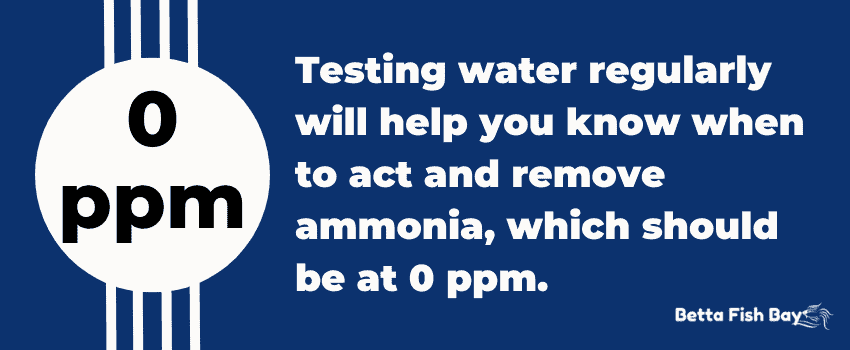
Testing your aquarium water on a regular basis helps you correct ammonia issues before they cause major problems.
Ammonia testing kits come in the form of test strips and liquids you place in test tubes.
Liquid test tube kits are more expensive but are usually more accurate than test strips.
All-inclusive aquarium water test kits also measure pH, nitrite, and nitrate levels.
An aquarium test kit is an important component of fishkeeping.
When setting up a new tank, you must test your water often during the early stages of the nitrogen cycle. Daily testing is necessary when doing a fish-in cycle.
Testing your aquarium water lets you know if the nitrogen cycle is making progress.
If your tests show elevated ammonia levels, the beneficial bacteria colonies have not become established.
When the tests start showing lower ammonia levels and increased nitrite levels, you know the nitrogen cycle is well underway.
In a cycled tank, water testing can alert you to an ammonia spike. A spike in ammonia can cause severe health issues in your betta.
If you catch the problem early, you may decrease the risk of ammonia poisoning in your fish.
Maintaining optimal water quality can prevent illness and prolong your betta’s life.
Pay attention to your pH levels, as well. The ideal pH level for a betta ranges from 6.5 to 7.0.
When your tank water is too acidic or alkaline, your fish is more prone to health issues.
High pH levels also increase the toxic effects of ammonia. This creates a very dangerous situation for your betta.
3. Choose the Right Filtration System
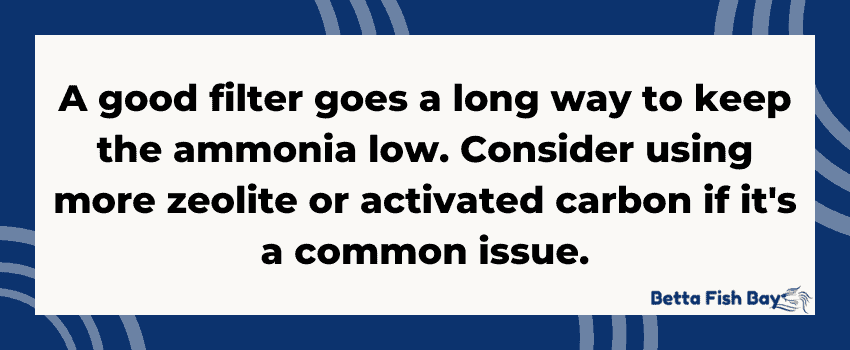
The right filtration system can help lower ammonia levels in your fish tank.
There are several types of filters, including:
- Sponge filters
- Hang-on-back filters
- Canister filters
- Under-gravel filters
Sponge and hang-on-back filters work well in smaller tanks. These types of filters do not take up a lot of space in the tank.
A sponge filter also encourages the growth of beneficial bacteria on its porous surface.
Canister filters are a great choice for larger tanks. A canister filter sits underneath the fish tank and uses an air pump to move water in and out of the filter.
Under-gravel filters are less common but still worth a mention. This type of filter sits underneath your substrate and filters debris in the gravel.
These filters are not as popular because they become clogged, and cleaning them is difficult.
You must use a filter with a low flow output in a betta tank. Bettas cannot swim well against strong currents because of their long fins.
Most filters use a 3-stage filtration system. This means the filter uses mechanical, chemical, and biological filter media.
If you have elevated ammonia levels in your fish tank, consider adding zeolite or activated carbon filter media.
Zeolite and activated carbon are efficient in removing ammonia, heavy metals, and medications from aquarium water.
But zeolite and activated carbon are best for short-term use.
Long-term use of zeolite and activated carbon can remove too many nutrients from your water column. This can starve your beneficial bacteria and disrupt your nitrogen cycle.
These types of filter media may also starve your plants of important nutrients needed for photosynthesis.
4. Perform Regular Water Changes and Tank Maintenance
Regular water changes help prevent the accumulation of ammonia and other toxins in your fish tank.
Water changes also add nutrients and oxygen back into the aquarium water.
Poor fish tank maintenance leads to ammonia buildup and bacteria growth. This causes cloudiness and puts your betta at risk for diseases and infections.
If you do not have a lot of plants, nitrates can build up to dangerous levels for your fish. High nitrate levels also make the tank water more acidic.
How often you perform water changes depends on your tank size and bioload. Testing your water parameters before a water change gives you an idea of how fast ammonia accumulates in your aquarium.
Smaller aquariums, such as 5- and 10-gallon tanks, need weekly partial water changes. Due to the low water volume, small tanks are more prone to changes in water parameters.
For tank sizes of 20 gallons or more, water parameters are usually more stable. You may get by with biweekly water changes instead.
But if you have your betta in a community tank with several tank mates, weekly water changes are necessary due to the increased bioload.
Aim for removing no more than 20%-25% of the tank water each time. Removing more than this can upset your beneficial bacteria colonies and ruin your nitrogen cycle.
Tips for Performing a Partial Water Change
Use a gravel vacuum for siphoning out the tank water. During this process, remove uneaten food and other organic matter from the substrate.
Clean algae from the sides of the tank with an algae scraper. If you make a habit of doing this during every water change, you will not have a lot of algae buildup.
Treat new tank water with a water conditioner before adding it to the tank. The water conditioner removes chlorine from tap water, making it safe for your fish.
You must also ensure the new water is close to the same temperature as your tank water. Sudden temperature changes can send your betta into shock.
Establish a regular cleaning routine and stick to it.
Regular tank maintenance is vital to the health of your fish. Poor water quality is the most common reason for fish diseases.
5. Add Live Plants

Live aquatic plants feed on ammonia as a source of nitrogen for photosynthesis.
Root-feeding plants are more efficient in consuming ammonia because they need more nutrients for healthy growth.
Some excellent aquarium plant choices for a betta tank include:
- Amazon Sword
- Java Fern
- Java Moss
- Anubias
- Hornwort
Here’s our article on small aquarium plants if you want to see more.
But plants cannot remove all the ammonia from your fish tank on their own. Aquarium plants cannot metabolize ammonia faster than a fish produces it.
Even in a heavily planted tank, you still need a filter and regular water changes to prevent ammonia buildup.
When aquatic plants die, they release ammonia back into the water. Removing dead plant matter prevents ammonia spikes in your aquarium.
6. Prevent Ammonia Buildup with Proper Feeding and Stocking
Proper feeding and stocking play a crucial role in controlling ammonia levels in your fish tank.
Overfeeding increases ammonia buildup in two ways.
When your betta eats more food, it produces more fish waste. As this fish waste accumulates on the substrate, it releases ammonia as it decays.
Uneaten food also sinks to the substrate, where it rots and releases ammonia.
Feeding your betta smaller amounts and removing uneaten food right after mealtime prevents ammonia buildup.
Betta fish have small stomachs, and overfeeding can cause health issues like bloating and constipation. In severe cases, bloating or constipation may lead to more serious diseases like swim bladder disorder or dropsy.
The proper meal size for a betta is 2-4 pellets twice per day. Spacing these meals 6-8 hours apart lets your betta digest its food before the next feeding.
Overstocking your fish tank is also a common reason for increased ammonia levels.
Having too many fish in an aquarium creates more of a bioload than the filter can handle.
Even with regular aquarium maintenance, an overcrowded tank is a toxic environment for fish and plants.
As a general rule, there should only be 1″ inch of fish per gallon of water. This rule applies to tropical fish like bettas as well as potential tank mates like otocinclus catfish, snails, and shrimp.
Giant bettas grow much larger than normal bettas, so they need even more room. A 10-gallon tank is the smallest recommended size for a giant betta.
Consider upgrading the size of your tank if you have multiple fish and ongoing ammonia issues.
7. Use Water Conditioners to Detoxify Ammonia
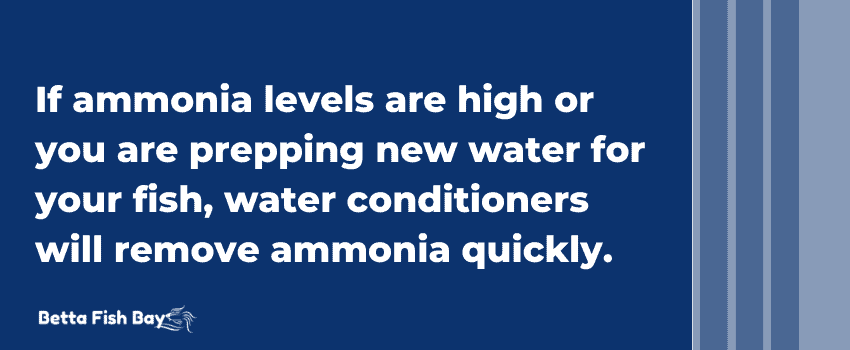
You may already know your tap water contains minerals and certain chemicals like chlorine. Chlorine makes tap water suitable for drinking, but it is dangerous for fish.
But many municipal water sources also add chloramine. Chloramine is a combination of chlorine and ammonia.
For the safety of your fish, you must use a water conditioner before adding tap water to your fish tank. Most water conditioners detoxify chlorine and chloramine, neutralizing ammonia and other toxic chemicals.
Some water conditioners also neutralize other forms of ammonia along with nitrites, nitrates, and heavy metals.
There are also standalone ammonia neutralizers available for emergencies.
The neutralizing effect lasts for 48 hours, allowing your filter to remove the harmful substances from the water.
When using a water conditioner or ammonia remover, always follow the dosage instructions on the product label.
The plastic cap for these products usually has measurements for precise dosing.
Dosing smaller tanks with water conditioners is a bit of a challenge. For betta tanks smaller than 20 gallons, consider using a syringe for the correct dose.
Add the water conditioner to your new tank water before adding it to the fish tank.
Mix the solution and let it sit for a few minutes so the water conditioner can take effect.
If you have a buildup of ammonia, do a partial water change before adding an ammonia removal product.
Test your water daily until your ammonia levels are back to 0 ppm.
8. Increase Aeration
Ammonia thrives in still waters, and low oxygen levels cause quick decay of organic matter.
Combat ammonia by providing more aeration in your betta tank.
Aeration keeps the tank water moving and increases oxygen levels to slow the decay of organic matter.
It also helps with diffusing ammonia gas, so it gets released above the water’s surface.
Air stones, bubblers, and air pumps are all effective in increasing aeration in your betta tank.
Stay mindful of the water currents for your betta. Bettas cannot swim well in strong currents because of their long, flowy fins.
But the benefits of aeration for reducing ammonia can outweigh the negatives.
If the currents are too strong for your betta, remove the air pump or air stone as soon as ammonia levels go back to 0 ppm.
9. Lower the pH Levels
The pH levels in your fish tank have a direct correlation to the toxic effects of ammonia.
In low pH levels, ammonia exists in the form of ammonium. Ammonium is less toxic to fish because it cannot pass through cell membranes.
As pH levels rise above 7.0, ammonium converts to more toxic ammonia.
Lowering your tank’s pH levels does not remove ammonia. But, a lower pH can convert ammonia back into less toxic ammonium until you find a solution for complete removal.
Ideal pH levels for betta fish range from 6.5 to 7.0. Lowering pH levels below 7.0 makes the water more acidic.
Take care not to lower pH levels too fast. Sudden changes in pH levels can cause shock in your betta.
Test your pH levels weekly and ensure they are safe for your fish.
There are several ways you may lower your tank’s pH levels.
Chemicals
Chemical pH buffers are a last resort solution. These chemicals make drastic changes to your pH levels in a short amount of time.
This sudden change may cause shock in your fish and some of the chemicals are unsafe for aquarium plants.
Many of these pH buffers contain sulfuric acid, sodium bicarbonate, or citric acid.
The pH-lowering effects are sometimes temporary. Your tank’s pH levels may rebound in a short amount of time, creating an unstable environment.
Peat Moss
Peat moss is a much safer alternative to pH-buffering chemicals.
It lowers pH levels by releasing gallic acid and tannins into the water.
There are several methods for using peat moss as a pH buffer in your fish tank.
Peat moss can work well when added to your filter media or layered onto your substrate.
Another method is soaking the peat moss in a separate container of water and adding the water to your fish tank.
Always soak peat moss in water regardless of which method you use. This prevents the peat moss from discoloring your tank water.
Add peat moss in small amounts and check your pH levels. You may add more as needed.
Driftwood
Another natural method of lowering your tank’s pH levels is adding a piece of aquarium driftwood.
Driftwood lowers pH levels by releasing tannins.
Like peat moss, driftwood can turn your water yellow. But this is harmless to your fish.
You may buy aquarium driftwood or create your own.
To do this, you must boil the piece of driftwood in a saltwater solution. This sterilizes the driftwood and removes debris and fungi.
Indian Almond Leaves
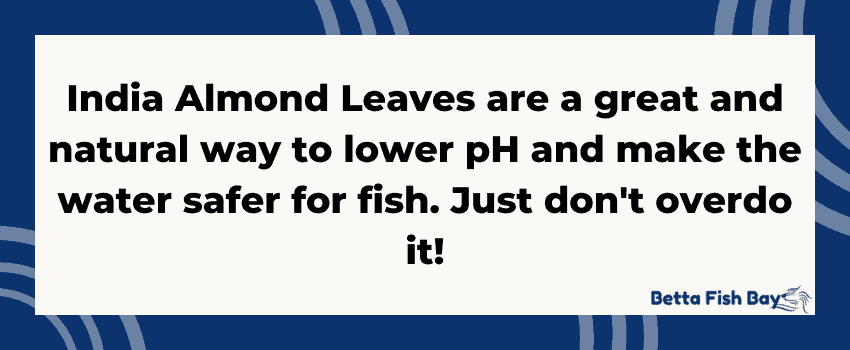
Indian almond leaves also use tannins for lowering pH levels in a fish tank.
These leaves are inexpensive, and dosing is easy. One Indian almond leaf per 10 gallons of water can lower pH levels.
Due to the tannins, Indian almond leaves also stain your tank water. Many aquarists use these leaves to create a blackwater environment for betta fish.
Indian almond leaves also have antifungal and antibacterial properties.
You may place an Indian almond leaf into your fish tank or boil the leaves for a concentrated tank additive.
Carbon Dioxide Reactors
Carbon dioxide reactors lower pH levels by releasing a steady stream of CO2. The device uses a reaction chamber where water absorbs carbon dioxide before it flows back into the aquarium.
This constant flow of carbon dioxide also encourages healthy plant growth.
A CO2 sensor and an O2 sensor can help you monitor carbon dioxide and oxygen levels in your fish tank.
Reverse Osmosis
Reverse osmosis units filter dissolved solids from the water. This includes chlorine, minerals, and toxins, which can contribute to increased pH levels.
These units are expensive and require extra tank maintenance.
Since reverse osmosis units remove beneficial minerals and nutrients, you must add these back to your tank water.
Adding the wrong amount of nutrients can disrupt water parameters and affect the health of your fish and plants.
Water Changes
Regular water changes are a simple way of lowering your tank’s pH levels.
Water changes remove toxins like ammonia, nitrite, and nitrate, which can increase pH levels.
Always add a water conditioner to new water before adding it to your tank. Also, ensure the temperature of the new water is close to the temperature of your tank water.
How To Identify and Treat Ammonia Poisoning in Betta Fish
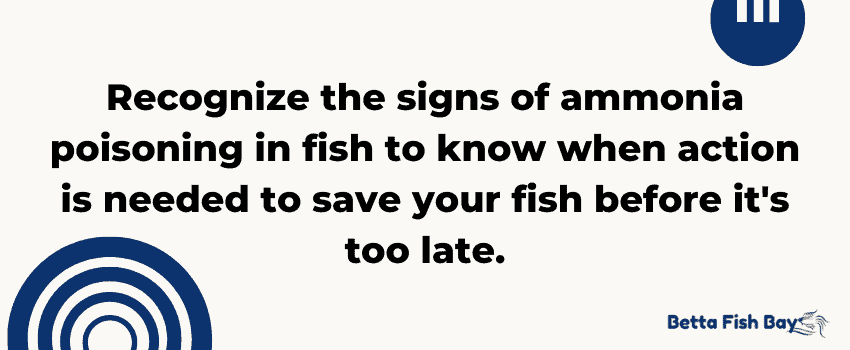
When your fish tank has elevated ammonia levels, your betta can suffer from ammonia poisoning.
Symptoms of ammonia poisoning in betta fish include:
- Red or purple gills
- Bloody wounds on the body
- Gasping for air
- Lethargy
- Loss of appetite
- Lying on the bottom of the tank
If you notice any of these symptoms in your betta, move your fish to a quarantine tank right away. Your betta can only recover when it is no longer exposed to ammonia.
Antibacterial medications can treat your betta’s open wounds and prevent infection.
Use the methods above to remove excess ammonia from your betta tank.
Keep testing your water until the readings show 0 ppm of ammonia.
Do not place your betta back into the tank until the water is safe again. Ammonia levels as low as 0.25 ppm can prevent your fish from healing.
Even after getting ammonia levels under control, your betta’s recovery can take several weeks, depending on the severity of the poisoning.
If you continue having ammonia spikes in your fish tank, you must find the source of the increased ammonia levels.
Troubleshooting and Common Mistakes
The most common cause of ammonia spikes in fish tanks is an incomplete nitrogen cycle.
Many new betta owners are unaware of the nitrogen cycle and why it’s so important.
Establishing a nitrogen cycle before adding your fish can help maintain stable water parameters and prevent ammonia spikes.
Once you establish beneficial bacteria colonies, you must preserve them.
Removing too much water during weekly water changes can disrupt the balance of nutrients these helpful bacteria feed on.
Rinsing your biological filter media in tap water also kills beneficial bacteria colonies.
If you must clean your biological media, rinse it in
Certain medications and aquatic plant fertilizers can harm the beneficial bacteria as well.
Poor tank maintenance is another common reason for ammonia spikes.
A weekly tank cleaning and partial water change can prevent ammonia buildup.
During the water change, vacuum your substrate to remove uneaten food, fish waste, and other debris. Remove algae and dead plant leaves, as well.
Final Thoughts on Removing Ammonia From Fish Tanks
Always keep a close watch on your fish tank’s ammonia levels.
Ammonia can make your fish very sick. In severe cases, ammonia poisoning is fatal.
Establishing proper tank cleaning and water change practices helps prevent ammonia spikes.
The nitrogen cycle plays a vital role in keeping ammonia levels down and your fish safe.
If you do face increased ammonia levels, following the steps above can remedy the issue.


